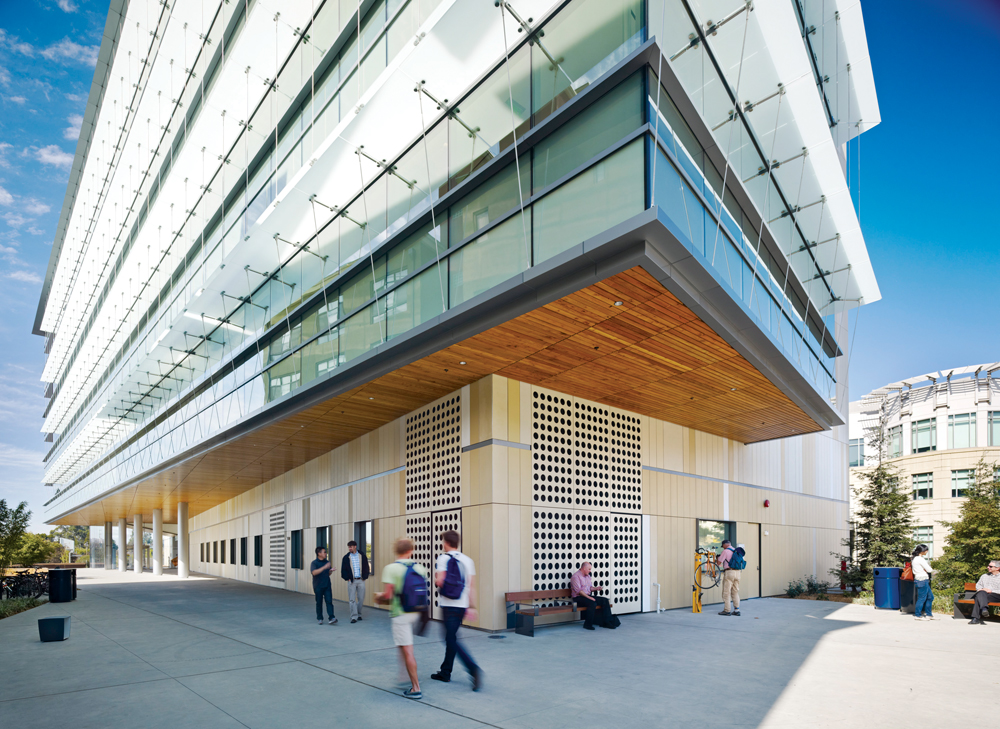After an era of biology-oriented spending—largely driven by Big Pharma and government concerns about bioterrorism—climate change is reshaping priorities in science and technology construction. “Engineering and chemistry funding are going up now, as is energy research, which seems to continue to get federal funding,” says Andy Vazzano, FAIA, LEED AP, Science and Technology Practice Leader at SmithGroupJJR. “Meanwhile, the sequester and budget cuts are having a negative impact on NIH funding for biomedical research.”
The focus on human health hasn’t totally faded, with many research universities still building new labs—especially those that tie research to clinical practice. “Anything that begins with ‘trans’ or ‘inter’ is still a major trend,” says Ryan Abbott, Science and Technology Project Director at Sundt Construction and a BD+C “40 Under 40” honoree (Class of 2012). “Translational, interdisciplinary. Modern science is a team sport.”
TOP S&T SECTOR ARCHITECTURE FIRMS
2012 S+T Revenue ($)1 HDR Architecture $91,252,0002 Perkins+Will $48,373,5683 HOK $38,347,0004 Stantec $33,111,4695 SmithGroupJJR $26,400,0006 Flad Architects $21,480,0007 Payette $18,434,0298 ZGF Architects $16,214,2679 EwingCole $11,000,00010 FKP Architects $10,250,000
TOP S&T SECTOR ENGINEERING FIRMS
2012 S+T Revenue ($)1 Affiliated Engineers $19,824,0002 Middough $13,900,0003 URS Corp. $11,772,1244 Bard, Rao + Athanas Consulting Engineers $10,500,0005 RMF Engineering Design $9,200,0006 Vanderweil Engineers $7,851,9007 Paulus, Sokolowski and Sartor $7,500,0008 WSP USA $5,772,0959 Science Applications International Corp. $3,103,15210 STV $2,937,000
TOP S&T SECTOR CONSTRUCTION FIRMS
2012 S+T Revenue ($)1 Skanska USA $376,717,4742 DPR Construction $298,563,6423 Suffolk Construction $290,560,3074 Manhattan Construction $199,444,0005 Whiting-Turner Contracting Co., The $193,160,4256 JE Dunn Construction $184,799,0517 Clark Group $174,348,8048 Turner Corporation, The $157,490,0009 Structure Tone $143,798,00010 Consigli Construction $74,568,263
Though the purpose-built med school building is the iconic face of S+T, adaptive reuse is getting a second look for advantages in cost and speed. Many clients are also seeking higher levels of green; LEED Platinum, once thought impossible for labs, is no longer unique, and clients are increasingly eyeing net-zero.
In addition, look for public/private partnerships to assume a greater role, even in the rarefied atmosphere of the Ivy League. Harvard, for instance, has rethought its Allston science campus during a recession hiatus. When the site cranks up again next year, the program will include a 36-acre, privately developed “enterprise research campus” for related companies in pharma, biotech, and venture capital.
Read BD+C's full Giants 300 Report
Related Stories
| Apr 5, 2011
Top 10 Buildings: Women in Architecture
Making selections of top buildings this week led to a surprising discovery about the representation of women in architecture, writes Tom Mallory, COO and co-founder, OpenBuildings.com. He discovered that finding female-created architecture, when excluding husband/wife teams, is extremely difficult and often the only work he came across was akin to interior design.
| Apr 5, 2011
What do Chengdu, Lagos, and Chicago have in common?
They’re all “world middleweight cities” that are likely to become regional megacities (10 million people) by 2025—along with Dongguan, Guangzhou, Hangzhou, Shenzhen, Tianjin, and Wuhan (China); Kinshasa (Democratic Republic of the Congo); Jakarta (Indonesia); Lahore (Pakistan); and Chennai (India), according to a new report from McKinsey Global Institute: “Urban World: Mapping the economic power of cities”.
| Mar 30, 2011
China's low-carbon future city
In 2005, the Chinese government announced its target to reduce energy consumption per GDP unit by 20% by the year 2010. After a multi-billion investment, that target has been reached. The Chinese Climate Protection Program’s goal to increase energy efficiency, develop renewable energies, and promote energy savings while reducing pollutant emissions and strengthening environmental protection is reflected in the “Future City” by SBA Design.
| Mar 30, 2011
Is the AEC industry at risk of losing its next generation leaders without better mentoring?
After two or three horrifying years for the AEC industry, we are finally seeing the makings of a turnaround. However, data developed by Kermit Baker as part of the AIA Work-on-the-Boards survey program indicates that between 17% and 22% of design firms are eliminating positions for interns and staff with less than six years of experience. This data suggests the industry is at risk of losing a large segment of its next generation of leaders if something isn't done to improve mentoring across the profession.
| Mar 29, 2011
City's design, transit system can ease gas costs
Some cities in the U.S. are better positioned to deal with rising gas prices than others because of their design and transit systems, according to CEOs for Cities, a Chicago-based nonprofit that works to build stronger cities. The key factor: whether residents have to drive everywhere, or have other options.
| Mar 29, 2011
Chicago’s Willis Tower to become a vertical solar farm
Chicago’s iconic Willis Tower (formerly the Sears Tower) is set to become a massive solar electric plant with the installation of a pilot solar electric glass project.
| Mar 29, 2011
Read up on Amazon.com's new green HQ
Phase IV of Amazon’s new headquarters in Seattle is nearly complete. The company has built 10 of the 11 buildings planned for its new campus in the South Lake Union neighborhood, and is on-track for a 2013 grand opening.
| Mar 29, 2011
Portuguese architect Eduardo Souto de Moura wins Pritzker Architecture Prize
Portugese architect Eduardo Souto de Moura, whose precisely-honed buildings reflect the influence of the late Chicago modernist Mies van der Rohe, is the 2011 winner of the Pritzker Architecture Prize, the field's highest honor.
| Mar 25, 2011
Qatar World Cup may feature carbon-fiber ‘clouds’
Engineers at Qatar University’s Department of Mechanical and Industrial Engineering are busy developing what they believe could act as artificial “clouds,” man-made saucer-type structures suspended over a given soccer stadium, working to shield tens of thousands of spectators from suffocating summer temperatures that regularly top 115 degrees Fahrenheit.












